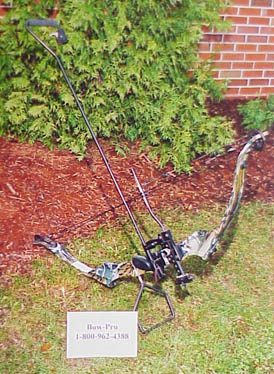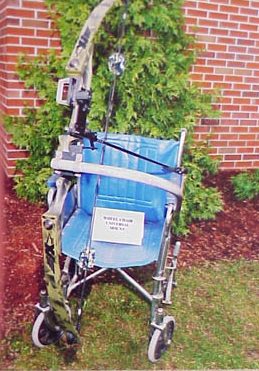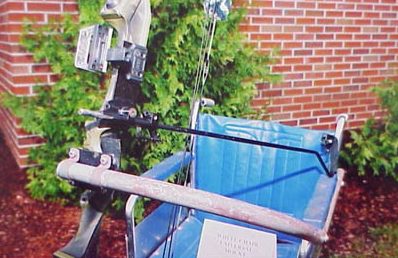There has been an intense effort to permit individuals with disabilities to use a crossbow during the archery-only season here in NY. Most of the requests are made by crossbow manufacturers and known crossbow supporters. Bowhunters are very skeptical of such actions since they are just an attempt by crossbow promoters to get a foot in the door for enhanced seasons in the future.
Many bowhunters who are physically challenged use modified archery equipment to successfully take big game. These hunters include individuals who are blind, wheelchair bound, those with the use of only one arm, people with very little body mobility and many others. Crossbow promoters are saying that the physically challenged, seniors, youth, and female hunters need the crossbow to participate in the archery only season. Nothing could be further from the truth. This is just another attempt to invade the archery-only seasons under the disguise of helping the Weak”. Women, youth and seniors are currently enjoying all hunting seasons without the use of the crossbow. With let-offs of 85% or more on modem compound bows a person pulling 35 pounds is only holding 5 pounds at full draw. For those few individuals that can not draw a bow there is the “Handicapped Archers Permit”. The permit allows qualified individuals to hunt with a bow equipped with a wide variety of available devices. The NYB Physically Challenged Committee has helped many individuals in this regard and will continue to do so.
The Physically Challenged Committee was formed to assist those Physically Challenged hunters who thought that they would never again be able to bowhunt, to in fact enjoy our sport once again. The NYB Physically Challenged Committee has led the nation in developing innovative accessories and techniques which allows Physically Challenged hunters to legally bowhunt with modified archery equipment. The Physically Challenged Committee has helped numerous hunters from across New York State and the country to get back out into the outdoors to enjoy bowhunting once again. This list of hunters includes paraplegics, quadriplegics, amputees, the blind and the deaf to name just a few. Many other hunters with various illnesses and diseases have also been helped by the committee.
For more information on available physical challenged equipment please contact NYB or DEC, Hunter Education Dept. at 625 Broadway, Albany, NY 12233. An informative video tape titled “ARCHERY: THE SPIRIT IS ALIVE” may be obtained for $21.95 from: The US Archer, 7315 N San Anna Drive, Tucson, AZ 85704. The video highlights many of devices that are available to the physical challenged hunter.
NYB does not endorse any of this equipment. This information is here solely to assist Physically Challenged hunters seeking guidance.
ADAPTIVE EQUIPMENT PRESENTATION
 New York Bowhunters, Inc. recognized the importance of assisting the Physically Challenged early in our organizations history. Since the inception of the Physically Challenged Committee, NYB has actively developed and worked in partnerships with companies and individuals who have developed adaptive equipment for Physically Challenged hunters. We have also worked hard to educate hunters in the proper selection of archery gear for the Physically Challenged hunter. Depending on the hunters physical limitations, many times an adjustment in the archery gear being used by the hunter, which in most cases is the bow, can help the hunter continue to enjoy the archery season without any special adaptive devices. For the hunter who cannot hunt by changing to a new or more forgiving bow, many adaptive devices are available to assist them in participating in archery. Because a picture is worth a 1000 words, please follow a sampling of the equipment which is available and that has successfully allowed Physically Challenged hunters to become active in the outdoors and to harvest game once again.
New York Bowhunters, Inc. recognized the importance of assisting the Physically Challenged early in our organizations history. Since the inception of the Physically Challenged Committee, NYB has actively developed and worked in partnerships with companies and individuals who have developed adaptive equipment for Physically Challenged hunters. We have also worked hard to educate hunters in the proper selection of archery gear for the Physically Challenged hunter. Depending on the hunters physical limitations, many times an adjustment in the archery gear being used by the hunter, which in most cases is the bow, can help the hunter continue to enjoy the archery season without any special adaptive devices. For the hunter who cannot hunt by changing to a new or more forgiving bow, many adaptive devices are available to assist them in participating in archery. Because a picture is worth a 1000 words, please follow a sampling of the equipment which is available and that has successfully allowed Physically Challenged hunters to become active in the outdoors and to harvest game once again.
Shoulder, Elbow, Arm, Wrist, Back, Etc.
A hunter experiencing problems with the shoulder, wrist, arm, elbow or back has several options open to them before looking at any of the adaptive devices as shown below. These options include the following:
- Choose a light mass weight bow in the 2.5-3.0 lb. range. By lighting the mass weight of the bow, the hunter takes additional stress away from the wrist, forearm and elbow.
- Choose bows which have round wheel eccentrics or soft cams. Dual cam bows with hard cams take their toll on the back, shoulder and elbow. By utilizing a softer wheel or cam, additional stress from drawing back the bow is relieved from these areas. Hunters may find that some solo cam bows also draw very smoothly and can be utilized by the Physically Challenged hunter.
- Choose a bow with a Deflexed riser. A Deflexed riser is more forgiving and makes for a smoother drawing bow.
- Choose a bow with an axle to axle length of at least 36 inches. Bows with longer axle to axle lengths are more forgiving and make for a smoother drawing bow. They also place less stress on the hunters hand and wrist while drawing the bow.
- Choose a bow with a maximum draw weight in the 35 50 lb. draw weight range. The minimum legal bow weight in New York is 35 lbs. of peak draw weight, so weights lower than this are not recommended. Weights of higher than 50 lbs. aren’t required for the taking of any game animal hunted in NY, including the black bear. By keeping the draw weight range to a reasonable level, a large percentage of Physically Challenged hunters can continue to utilize archery gear without the need for any adaptive drawing or holding devices.
- Start shooting a bow early with the poundage set as low as possible and which still allows the hunter to draw it back comfortably. Every few weeks increase the poundage by 2-3 pounds until your target hunting weight has been achieved.
- Once hunters are able to shoot their bows, limit practice to no more than every other day to allow proper rest of fatigued muscle groups.
For those Physically Challenged hunters who have explored the above options and are still having problems with their ability to hunt, the below adaptive equipment can be used for any number of Physical Disabilities involving the shoulder, elbow, wrist or arm injuries as well as by limb amputees. The devices assist the hunter in drawing the bow and holding it at full draw, taking the pressure off of weak or injured muscles or limbs. This allows the hunter to continue enjoying the sport of archery with normal archery equipment and allows them the peace of mind to concentrate on making the shot instead of worrying about their physical limitations.
Pullin Archery

The Pullin Archery device assists the Physically Challenged archer with his or her bow set-up. The device can be used for any number of Physical Disabilities such as; shoulder, elbow, wrist or arm injuries or by limb amputees. The device assist the hunter in drawing the bow and holding it back at fulldraw, taking the pressure off of weak or injured muscles or limbs. Pullin Archery Products, Inc can be reached at P.O. Box 78, McDowell, VA 24458. Phone/Fax 540-885-1250. To see more about Pullin Archery Click Here
Blind Archers Equipment
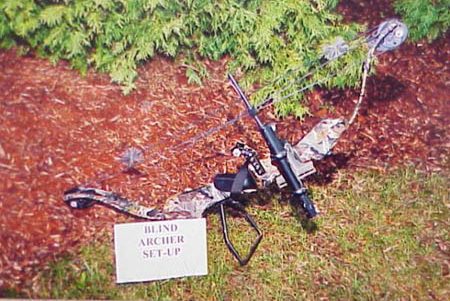
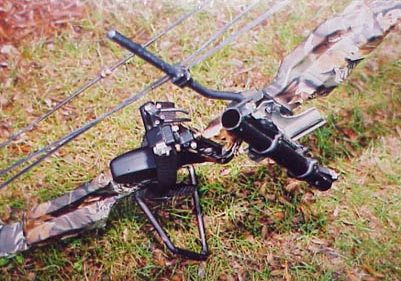
The set-up as shown below can be utilized by a blind archer. The archer has a hunting companion who sights the target for them and uses commands for adjusting the archers hold for left, right, up and down. The sighter then provides the correct signal or command for the archer to release the arrow towards their quarry. There have been instances of sighted archers not taken any big game animals when sighted but taking several animals after being blinded by uses adaptive equipment just as this.
The Draw-Loc
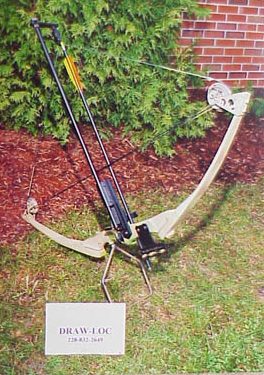
The Draw-Loc is similar to both the Pullin Archery device and Bow Pro.
Draw-Loc can be reached at 228-832-2619.
For More Information On The Draw-Loc Click Here
Wheel Chair Adaptive Equipment
The set-up as shown below can be utilized by an archer that is confined to a wheel chair. The bow support allows the bow to be held in front of the archer and the weight of the bow is distributed to the chair instead of to the archers arm. Once the bow has been drawn utilizing one of the earlier devices by the hunters companion, they may be able to position the bow and take a shot on their own. This of course depends on their level of disability.
